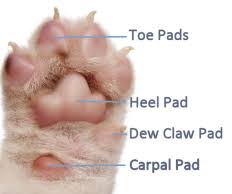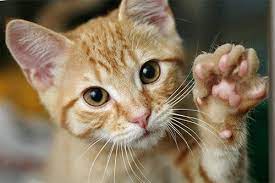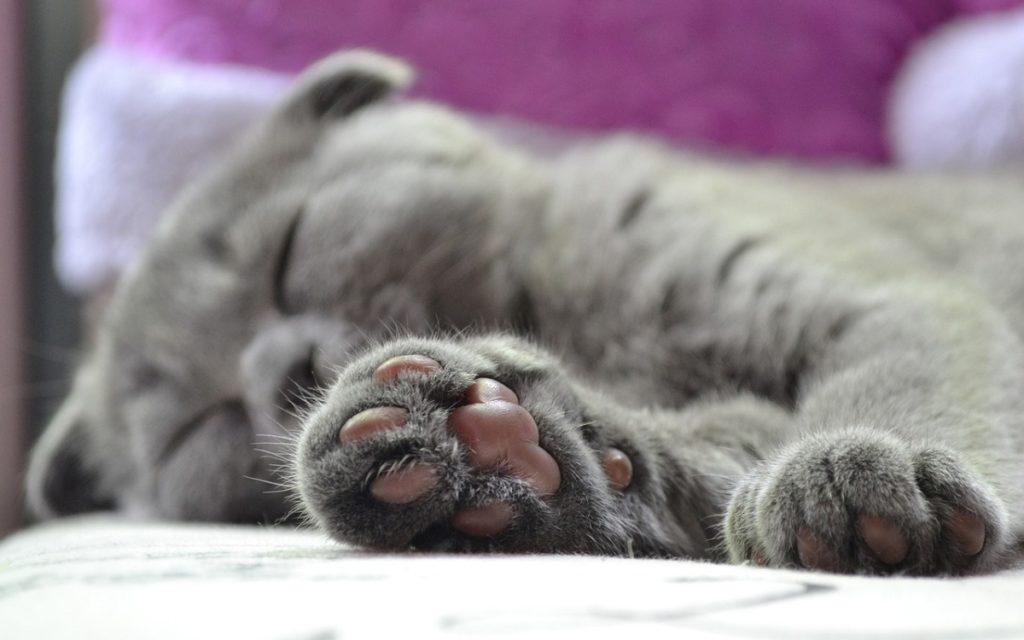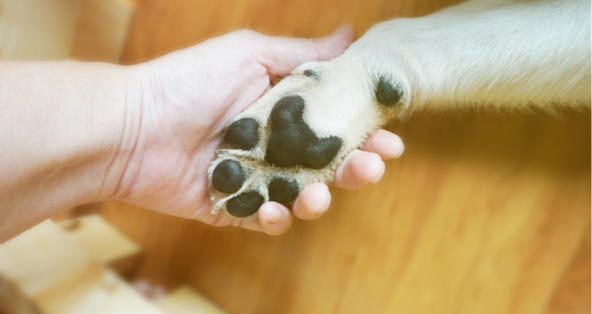Cats are amazing creatures—they’re agile and athletic, and they always seem to land on their feet. But have you ever wondered about their carpal pads?
The carpal pad, also known as the “knee of the cat”, is a small, black, triangular-shaped pad located on the back of the foreleg just above the paw.
The purpose of this pad is to provide traction and shock absorption when the cat is running or jumping.
In some cats, the carpal pad may be lighter in color or even missing altogether.
In this post, we’ll explore everything you need to know about cat carpal pads, from what they are made of to how you can care for them and everything in between. So keep reading to learn more!
What Is A Cat Carpal Pad?

Carpal pads are found on the back of a cat’s paw, between the metacarpal pad and the digital pads.
The carpal pad helps to protect the bones and tendons in the paw from injury. It also provides traction when a cat is walking on slippery surfaces.
There are two types of carpal pads: the cushion carpal pad and the webbed carpal pad.
The cushion carpal pad is found on the back of the paw, between the metacarpal pad and the digital pads. It is made up of fatty tissue and provides padding for the bones and tendons in the paw.
The webbed carpal pad is found on the underside of the paw, between the metacarpal pad and the digital pads. It is made up of webbing that helps to grip surfaces and provides traction when a cat is walking on slippery surfaces.
Carpal pads play an important role in a cat’s ability to walk and run. They help to protect the bones and tendons in the paw from injury and provide traction on slippery surfaces.
If a cat’s carpal pads are damaged, it can lead to pain and difficulty walking.
What Is It Made Of?
The carpal pad, also known as the “heel”, is a small, fleshy, triangular pad located on the back of a cat’s paw. It is composed of both fatty tissue and connective tissue.
The carpal pad acts as a shock absorber and provides traction when the cat walks or runs.
It also helps the cat to climb and provides insulation against cold temperatures.
How Can I Tell If My Cat Has A Healthy Carpal Pad?
A healthy carpal pad should be:
- Firm
- Smooth
- Supple
If your cat’s carpal pad is any of these things, chances are it’s healthy!
However, if you notice any changes in color or texture, or if the pad seems to be getting thinner, it’s time to take your cat to the vet.
Why Is My Cat’s Carpal Pad Hard?
If you’re wondering why your cat’s carpal pad is hard, it could be due to several reasons.
For one, the carpal pad acts as a shock absorber for the bones and joints in the front legs.
Additionally, the carpal pads help cats grip surfaces and keep their balance. So, if your cat’s carpal pads are hard, it’s likely because they’re doing their job!
Another reason your cat’s carpal pad may be hard is due to an injury. If your cat has been limping or seems to be in pain, there may be something wrong with their carpal pad.
In this case, it’s best to take them to the vet to get checked out.
How Can I Care For My Cat’s Carpal Pads?

If you want to keep your cat’s carpal pads healthy, there are a few things you can do.
First, make sure they have a balanced diet and access to plenty of water.
Additionally, you can gently massage their carpal pads with your fingers to help promote blood circulation.
Finally, keep an eye on their nails and trim them when necessary. By following these simple tips, you can help keep your cat’s carpal pads healthy and strong!
Why Is My Cat’s Carpal Pad Dry?
Cats typically groom themselves several times a day, and part of this grooming process includes licking their carpal pads. This helps to keep the pads moist and supple.
If your cat isn’t licking their pads enough, the pads can become dry and cracked.
A dry cat carpal pad may also signify a health issue. When a cat gets sick, they often groom themselves less.
If you notice your cat’s carpal pad is dry and they are also acting lethargic or have a decreased appetite, it’s a sure sign they have some form of ailment.
There are a few things you can do at home to help keep your cat’s carpal pads moist.
One is to apply a small amount of petroleum jelly or other moisturizers to the pads.
You can also try giving your cat wet food, as this will help increase their intake of water and keep their pads moist. If none of these works, it’s time to take your kitty to the vet.
Why Is My Cat’s Carpal Pad Black?
One common reason why the carpal pad may turn black is due to bruising. This can happen if your cat falls or jumps from a height and lands on their feet.
The pad may also turn black if it is constantly rubbing against a hard surface, such as a concrete floor.
If the pad is only mildly discolored, there is no need to take your cat to the vet. The bruise will eventually fade and the pad will return to its normal color.
If the carpal pad is severely bruised or black, it is important to take your cat to the vet. They will be able to determine if there is any more serious damage, such as a fracture.
If the pad is fractured, your cat will likely need surgery to repair the break.
In some cases, the carpal pad may turn black due to melanoma, which is a type of skin cancer.
If you notice any other changes in your cat’s appearance, such as a lump or mass on the pad, contact your vet immediately. They will be able to perform a biopsy to determine if the black color is due to melanoma or another cause.
Why Is My Cat’s Carpal Pad Scabbed?
Injury is the most common cause of a scabbed carpal pad. If your cat has been outdoors recently, they may have gotten into a fight with another animal or gotten scraped up on something sharp.
All it takes is a small cut or scrape for the carpal pad to become scabbed.
Allergic reactions are another possible cause of a scabbed carpal pad. If your cat is allergic to something in their environment, it can cause their skin to become irritated and inflamed. This can lead to the formation of a scab.
Dry skin is a less common cause of a scabbed carpal pad, but it can happen.
If your cat’s skin is dry and cracked, it can provide an entry point for bacteria and other foreign substances. This can lead to an infection, which can then result in a scab.
Why Is My Cat’s Carpal Pad Peeling?

There are several reasons why your cat’s carpal pad might be peeling. The most common reason is simply due to wear and tear—as your cat walks, their carpal pads will slowly start to peel away.
Other causes of peeling carpal pads include allergies, infection, or even cancer.
If you’re concerned about your cat’s carpal pad peeling, the best thing to do is take them to the vet for a check-up.
How Do You Treat An Injured Carpal Pad On A Cat?
The answer is you don’t—the vet does. We can’t overemphasize the importance of letting qualified professional deal with any sickness as self-medicating may make the problem worse.
If your cat has an injured carpal pad, the best thing you can do is take them to the vet.
The vet will be able to properly diagnose and treat the injury. In some cases, surgery may be required to fix the problem.
Do Carpal Pads Grow Back?
If your cat’s carpal pad is injured or damaged, you may be wondering if it will grow back.
The good news is that carpal pads can regenerate, so there’s a good chance your cat’s pad will grow back.
However, it may not grow back the same as it was before.
Parting Thoughts
Carpal pads play an important role in a cat’s life—they provide traction, help with balance, and protect delicate bones and tendons.
So, it’s essential to keep an eye on them and make sure they stay healthy!
We hope the information shared in this post will help you take better care of your cat’s carpal pads.
Related Posts:
Cat Paw Pads Turning Pink: What Does It Mean? (Plus what to do)
Normal Cat Paw Vs Polydactyl—A Complete Guide To Your Kitty’s Paws

Hi! I am Eleanor Price. I started this website after my cat, Louie, almost died from a case of botulism (a type of food poisoning often caused by bacteria that grow on food items). Turned out that my cat’s diet was the problem. I have made it my duty to provide the best information and recommendations about everything cat lovers need to know about their felines’ health and wellbeing. My goal is to find the most informative content on anything feline-related and share it with fellow hardworking kitty lovers.

